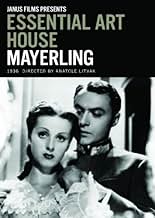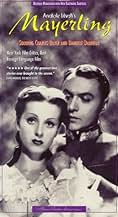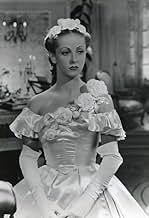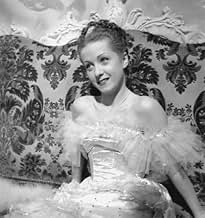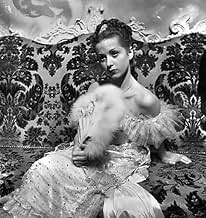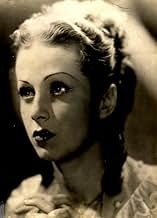L'histoire en 1889 dans l'empire hongrois, de l'archiduc Rodolphe de Habsbourg, qui marié, s'éprend pourtant d'une jeune fille.L'histoire en 1889 dans l'empire hongrois, de l'archiduc Rodolphe de Habsbourg, qui marié, s'éprend pourtant d'une jeune fille.L'histoire en 1889 dans l'empire hongrois, de l'archiduc Rodolphe de Habsbourg, qui marié, s'éprend pourtant d'une jeune fille.
- Réalisation
- Scénario
- Casting principal
- Récompenses
- 3 victoires et 1 nomination au total
Marthe Régnier
- La baronne Vetsera
- (as Marthe Regnier)
Assia Granatouroff
- La cousine de Marie
- (as Assia)
Christiane Ribes
- Une fille
- (as Ribès)
René Bergeron
- Szeps
- (as Bergeron)
Vladimir Sokoloff
- Le chef de la police
- (as Sokoloff)
Raymond Aimos
- Le premier policier
- (as Aimos)
André Siméon
- Le second policier
- (as Siméon)
Avis à la une
Historical drama, melodrama. The film adaptation of the novel of the same name by French writer Claude Anet, in turn based on real events. And since I have not read the original book source, therefore I will evaluate the film adaptation as an independent work, with an eye on real historical events, of course. This picture attracted me with the name of director Anatoly Litvak (Anatoly Mikhailovich Litvak) - a Soviet, European, and Hollywood director who shot a number of memorable pictures, personally I watched with pleasure his works such as "The Battle for Russia" (he was also a screenwriter, and the second director was Frank Capra) and "Night of the Generals" (a detective thriller about the Second World War). Both paintings are strongly recommended for viewing. But with "Mayerling" Anatole's career in Europe gave a sharp start, after the success of this picture he was invited to Hollywood. And here's my brief opinion for you - A romantic version of an old tragedy. There were both advantages and disadvantages in the picture, which should never be forgotten. And this concludes such an important introduction and gets to the point.
So, the advantages: 1. Scenario - if we do not take into account historical inaccuracies and various omissions (which will be discussed later), then we are faced with a tragic love story of the Archduke (heir to the throne) The Austro-Hungarian Empire of Rudolf and his young lover (actually mistress) Baroness Maria Vechera, who committed suicide on January 30, 1889 in the hunting castle of Mayerling (which is near Vienna). Rudolf is married, but unhappy in his marriage, and only acquaintance with seventeen-year-old Maria gave him hope for a better life. After all, the prince is also a liberal, and directly undermines the authority of his father in the state by supporting revolutionary-minded subjects. Moreover, this picture does not consider the political version of suicide, because everything is put in such a way that it is the romantic version that is correct. Indeed, it is the most common and the most studied. And the script itself is built in such a way that the viewer becomes completely on the side of Rudolf and Maria, who were simply driven into a trap - and they decided to get out of it in an unconventional way. Kurt Cobain would have approved of such a passage. In an hour and a half we were shown the life of Rudolf and how he came to such a decision, as well as the life of young Maria, who followed her beloved in the best traditions of romantic literature and the great tragedy of William Shakespeare. It was interesting to watch. After all, the dialogues do not seem pretentious, and the acting is at a high level.
2. Romance - the line between Rudolf and Maria is very good. A young beauty and a married crown prince, unhappy in marriage, therefore often carouses, drowning out the pain with alcohol and easily accessible women, until she accidentally meets Maria - such a pure and innocent soul who fell in love with him at first sight, and after all, his title is not important to her. How naive and beautiful it looks. Now such a thing is almost impossible to meet. A pity. I would like to quote Hippolytus from the famous New Year's tragicomedy by Eldar Ryazanov. There is that "spark" between Rudolf and Maria, which cannot be confused with anything. How they look at each other! This is love!
3. Atmosphere - the creators managed (in general) to recreate the atmosphere of the Austro-Hungarian Empire of the late eighties of the nineteenth century, with its revolutionary movement (mainly Hungarians and Bohemians), turbulent foreign policy situation, problems in the imperial family. And although we are focused only on the latter, revolutionary sentiments are still reflected at the very beginning of the picture (although the very first appearance of the Crown Prince raises questions). Banners, standards - everything is very reminiscent of the now-defunct empire.
So, the cons: 1. Historical inaccuracies - soldiers of the Austro-Hungarian army wear the famous "pikelhelms". Although similar helmets were worn in the Prussian - later German army, and also in the Life Guards of the Imperial Russian Army's Jaeger Regiment in the late forties of the nineteenth century, but the Austro-Hungarian wax did not have such helmets. There is practically no mention of strict morals and etiquette obligatory for the entire aristocracy here (and I'm not talking about the deliberately demonstrative behavior of Rudolf and Maria - everything is clear here). I'm sorry, but in those days this was very strictly monitored, and it was drummed into all the young aristocrats from childhood, so it's simply impossible to look at the promiscuity that is shown here. And these are only the most striking inaccuracies. I'm sure there are others.
2. Omission of important details - in reality, Crown Prince Rudolf, two years before the shots in Mayerling, wanted to pull off a similar trick with his long-term mistress Mizzi Kaspar, but the girl refused. And before leaving for Mayerling, Rudolf spent the last night with this very Mizzi. Moreover, the police ignored the suicide attempt of 1887. Rudolf himself was ill with venereal diseases (syphilis, gonorrhea), and in general he had poor health (whereas Shawl Boyer is the performer of the main role, and is bursting with health). Now you feel how the romance began to fade, and the attempt to self-heal in the company of an old acquaintance in 1887 was not so strange. I'm not talking about other versions of the tragedy (for example, politics).
A little about the main characters: 1. Archduke Rudolf, played by Charles Boyer, is the heir to the throne of the Austro-Hungarian Empire, who is constantly being watched, and who is unable to do anything without the permission of his august father. The only thing he is allowed is to carouse and have affairs with women, since his marriage was a purely political move (which was commonplace for all royal families, starting from the emergence of the first monarchies). And only a meeting with young Maria makes Rudolf go against the system and try to change it. Charles Boyer coped with the role perfectly. Although his image differs from the real Rudolf, he is shown very vividly in the picture. Bravo!
2. Baroness Maria of the Evening performed by Danielle Darye is a young baroness who is only seventeen years old. She could not even imagine that the courteous man in uniform who saved her from an annoying gentleman was Crown Prince Rudolf himself, and that a real love would break out between them, which, although it would end tragically, would leave a bright mark in history. Nineteen-year-old Mademoiselle Darie here amazes with her beauty, although she does not look much like the real Maria, nevertheless she was able to show on the screen the true love of a young girl for the unfortunate prince. Bravo!
This picture is the first film adaptation of the tragic love story of Crown Prince Rudolf and Maria. There are four more film adaptations (not counting theatrical productions, ballets, musicals, and so on), and they all tell exactly about the romantic version of the tragedy, and only the 1949 film adaptation (by the way, also French) also considers others. If you're interested, you can take a look.
My rating is 7 out of 10 and my recommendation for viewing!
So, the advantages: 1. Scenario - if we do not take into account historical inaccuracies and various omissions (which will be discussed later), then we are faced with a tragic love story of the Archduke (heir to the throne) The Austro-Hungarian Empire of Rudolf and his young lover (actually mistress) Baroness Maria Vechera, who committed suicide on January 30, 1889 in the hunting castle of Mayerling (which is near Vienna). Rudolf is married, but unhappy in his marriage, and only acquaintance with seventeen-year-old Maria gave him hope for a better life. After all, the prince is also a liberal, and directly undermines the authority of his father in the state by supporting revolutionary-minded subjects. Moreover, this picture does not consider the political version of suicide, because everything is put in such a way that it is the romantic version that is correct. Indeed, it is the most common and the most studied. And the script itself is built in such a way that the viewer becomes completely on the side of Rudolf and Maria, who were simply driven into a trap - and they decided to get out of it in an unconventional way. Kurt Cobain would have approved of such a passage. In an hour and a half we were shown the life of Rudolf and how he came to such a decision, as well as the life of young Maria, who followed her beloved in the best traditions of romantic literature and the great tragedy of William Shakespeare. It was interesting to watch. After all, the dialogues do not seem pretentious, and the acting is at a high level.
2. Romance - the line between Rudolf and Maria is very good. A young beauty and a married crown prince, unhappy in marriage, therefore often carouses, drowning out the pain with alcohol and easily accessible women, until she accidentally meets Maria - such a pure and innocent soul who fell in love with him at first sight, and after all, his title is not important to her. How naive and beautiful it looks. Now such a thing is almost impossible to meet. A pity. I would like to quote Hippolytus from the famous New Year's tragicomedy by Eldar Ryazanov. There is that "spark" between Rudolf and Maria, which cannot be confused with anything. How they look at each other! This is love!
3. Atmosphere - the creators managed (in general) to recreate the atmosphere of the Austro-Hungarian Empire of the late eighties of the nineteenth century, with its revolutionary movement (mainly Hungarians and Bohemians), turbulent foreign policy situation, problems in the imperial family. And although we are focused only on the latter, revolutionary sentiments are still reflected at the very beginning of the picture (although the very first appearance of the Crown Prince raises questions). Banners, standards - everything is very reminiscent of the now-defunct empire.
So, the cons: 1. Historical inaccuracies - soldiers of the Austro-Hungarian army wear the famous "pikelhelms". Although similar helmets were worn in the Prussian - later German army, and also in the Life Guards of the Imperial Russian Army's Jaeger Regiment in the late forties of the nineteenth century, but the Austro-Hungarian wax did not have such helmets. There is practically no mention of strict morals and etiquette obligatory for the entire aristocracy here (and I'm not talking about the deliberately demonstrative behavior of Rudolf and Maria - everything is clear here). I'm sorry, but in those days this was very strictly monitored, and it was drummed into all the young aristocrats from childhood, so it's simply impossible to look at the promiscuity that is shown here. And these are only the most striking inaccuracies. I'm sure there are others.
2. Omission of important details - in reality, Crown Prince Rudolf, two years before the shots in Mayerling, wanted to pull off a similar trick with his long-term mistress Mizzi Kaspar, but the girl refused. And before leaving for Mayerling, Rudolf spent the last night with this very Mizzi. Moreover, the police ignored the suicide attempt of 1887. Rudolf himself was ill with venereal diseases (syphilis, gonorrhea), and in general he had poor health (whereas Shawl Boyer is the performer of the main role, and is bursting with health). Now you feel how the romance began to fade, and the attempt to self-heal in the company of an old acquaintance in 1887 was not so strange. I'm not talking about other versions of the tragedy (for example, politics).
A little about the main characters: 1. Archduke Rudolf, played by Charles Boyer, is the heir to the throne of the Austro-Hungarian Empire, who is constantly being watched, and who is unable to do anything without the permission of his august father. The only thing he is allowed is to carouse and have affairs with women, since his marriage was a purely political move (which was commonplace for all royal families, starting from the emergence of the first monarchies). And only a meeting with young Maria makes Rudolf go against the system and try to change it. Charles Boyer coped with the role perfectly. Although his image differs from the real Rudolf, he is shown very vividly in the picture. Bravo!
2. Baroness Maria of the Evening performed by Danielle Darye is a young baroness who is only seventeen years old. She could not even imagine that the courteous man in uniform who saved her from an annoying gentleman was Crown Prince Rudolf himself, and that a real love would break out between them, which, although it would end tragically, would leave a bright mark in history. Nineteen-year-old Mademoiselle Darie here amazes with her beauty, although she does not look much like the real Maria, nevertheless she was able to show on the screen the true love of a young girl for the unfortunate prince. Bravo!
This picture is the first film adaptation of the tragic love story of Crown Prince Rudolf and Maria. There are four more film adaptations (not counting theatrical productions, ballets, musicals, and so on), and they all tell exactly about the romantic version of the tragedy, and only the 1949 film adaptation (by the way, also French) also considers others. If you're interested, you can take a look.
My rating is 7 out of 10 and my recommendation for viewing!
In my reviews of the 1968 Terence Young version,I've already told my thoughts on the historical facts.There's no need to get back on it:suffice to say the true story was not as romantic as sensitive people still thinks so today.
Anatole Litvak does not pass over in silence Rudolph's dissoluteness, as two orgy scenes testify.Besides,Charles Boyer is a much better archduke than Omar Shariff.Ditto Danielle Darrieux who was about 20 (whereas Catherine Deneuve was nearing 25 when she played Mary),thus a more credible baroness Vetsera .Both versions,it's important to notice ,are from Claude Anet's NOVEL.It's not a historian's work and it should be not looked upon so.
However,Litvak is a better director than Terence Young.With a much smaller budget,and of course without the 1968 technical aids ,he works wonders :the tiny church where Rudolph meets Mary in half-light creates a mystical and heathen atmosphere at once.The night at the opera house is dazzling.To conclude the scene of the ball at the German embassy ,the artist uses a stunning tracking out which leaves the swirling twirling dancers,then stops on a glass door adorned with the Habsburg emblem.Rudolphe ,firing at his reflection in a mirror is an adequate metaphor.
A minor flaw:Gabrielle Dorziat is completely miscast as Sissi ,Rudolph's mother:she was one of the most beautiful women of her time (we can see the magnificent Winterhalter portraits at the beginning of the movie).At fifty,when the Mayerling tragedy occurred,her beauty was still incomparable.She had nothing to do with the aging dowager we see on the screen (in Young 's version,it's Ava Gardner!)
And hats off to Danielle Darrieux who ,sixty-four years after "Mayerling" ,recently triumphed in "8 femmes",a blockbuster in France.Any advance?
Anatole Litvak does not pass over in silence Rudolph's dissoluteness, as two orgy scenes testify.Besides,Charles Boyer is a much better archduke than Omar Shariff.Ditto Danielle Darrieux who was about 20 (whereas Catherine Deneuve was nearing 25 when she played Mary),thus a more credible baroness Vetsera .Both versions,it's important to notice ,are from Claude Anet's NOVEL.It's not a historian's work and it should be not looked upon so.
However,Litvak is a better director than Terence Young.With a much smaller budget,and of course without the 1968 technical aids ,he works wonders :the tiny church where Rudolph meets Mary in half-light creates a mystical and heathen atmosphere at once.The night at the opera house is dazzling.To conclude the scene of the ball at the German embassy ,the artist uses a stunning tracking out which leaves the swirling twirling dancers,then stops on a glass door adorned with the Habsburg emblem.Rudolphe ,firing at his reflection in a mirror is an adequate metaphor.
A minor flaw:Gabrielle Dorziat is completely miscast as Sissi ,Rudolph's mother:she was one of the most beautiful women of her time (we can see the magnificent Winterhalter portraits at the beginning of the movie).At fifty,when the Mayerling tragedy occurred,her beauty was still incomparable.She had nothing to do with the aging dowager we see on the screen (in Young 's version,it's Ava Gardner!)
And hats off to Danielle Darrieux who ,sixty-four years after "Mayerling" ,recently triumphed in "8 femmes",a blockbuster in France.Any advance?
The story of the perceived (other conspiracy theories are available!) double-suicide of Archduke Rudolph of Austria and his teenage lover Baroness Marie Vetsera at Mayerling in 1889 is one of the great royal dynastic tragedies of the 19th Century and has even been named a contributory factor in the outbreak of the First World War some 25 years later.
In this French-language version by Ukranian director Anatole Litvak, we get a highly-romanticised version of the story with Charles Boyer and Danielle Darrieux as the star-crossed but ill-fated lovers.
The direction throughout is stylish and tasteful, Litvak impressing in his recreation of the Viennese Court with its surface splendour barely concealing the jostling for position and rumour-mongering beneath the facade. Boyer and Darrieux are excellent in their lead roles, his character the reforming, rebellious heir to the throne, unhappy in his arranged marriage and she the youthful, highly-impressionable innocent caught up in the first great passion of her life.
The concluding climax is sensitively and humanely depicted too with my only major criticisms of the film being an over-reliance on the use of the no-doubt in-vogue montage sequences and a tendency to slightly overstay the camera's welcome in certain scenes.
Nevertheless, this was a fine retelling of the notorious scandal and it's no surprise that its artistic and commercial success lured director Litvak to Hollywood where he enjoyed a distinguished career for many years.
In this French-language version by Ukranian director Anatole Litvak, we get a highly-romanticised version of the story with Charles Boyer and Danielle Darrieux as the star-crossed but ill-fated lovers.
The direction throughout is stylish and tasteful, Litvak impressing in his recreation of the Viennese Court with its surface splendour barely concealing the jostling for position and rumour-mongering beneath the facade. Boyer and Darrieux are excellent in their lead roles, his character the reforming, rebellious heir to the throne, unhappy in his arranged marriage and she the youthful, highly-impressionable innocent caught up in the first great passion of her life.
The concluding climax is sensitively and humanely depicted too with my only major criticisms of the film being an over-reliance on the use of the no-doubt in-vogue montage sequences and a tendency to slightly overstay the camera's welcome in certain scenes.
Nevertheless, this was a fine retelling of the notorious scandal and it's no surprise that its artistic and commercial success lured director Litvak to Hollywood where he enjoyed a distinguished career for many years.
'Mayerling' (1936)
Opening thoughts: There were plenty of reasons for seeing 'Mayerling'. Have always loved period dramas, and especially when it is a period of history that really piques a lot of interest. Having gained a major interest in Austrian royalty since my holiday to Vienna last year (especially Empress Elisabeth, aka Sissi), this was one such period. It also intrigued seeing Charles Boyer in an early role and the kind that he became well known for and for seeing one of Anatole Litvak's early films.
'Mayerling' is a very, very good film indeed. Not perfection, but there are numerous good things and most of those good things are actually exceptional. Of the two 'Mayerling' films seen, the other being the one from the 50s, this is infinitely better with it actually being good (was underwhelmed by the other). It is very easy to see why Boyer became a major international star after this and the film is one of Litvak's best and most interesting early films (the film that also helped make his career bigger), as far as his films in general go it's not quite 'All This and Heaven Too' and especially 'The Snake Pit' but it is in the better end.
Bad things: It isn't perfect. Will agree that Gabrielle Dorziat wasn't right for Elisabeth, she came over as too old and didn't get enough of the ahead of the time astonishing beauty that Elisabeth was famous for the struggles she faced in her life.
Also thought that the lead up to the tragic conclusion was too overlong and dragged out.
Good things: However, 'Mayerling' looks absolutely ravishing, with sumptuous costume designs and art direction and the photography is some of the most beautiful of any film from the late 30s. Was not sure as to whether Arthur Honegger's music would gel stylistically and in mood, but it is suitably dramatic without being bombastic or too melodramatic and is quite lush. Litvak's direction is some of his most stylish and sensitive.
Furthermore, the script is thought provoking and doesn't go into soap opera territory too much. There may be cliches here but they are not done in too cliched a manner. The story always intrigues, even in the slower patches, and has emotional impact and very passionate romance. The conclusion itself is very moving and the love is very deeply felt.
Boyer and Danielle Darrieux are both perfectly cast, giving performances of great dignity and passion. Their chemistry smolders. The supporting cast are excellent too, with reservations had for only Dorziat.
Concluding thoughts: Overall, very, very good.
8/10.
Opening thoughts: There were plenty of reasons for seeing 'Mayerling'. Have always loved period dramas, and especially when it is a period of history that really piques a lot of interest. Having gained a major interest in Austrian royalty since my holiday to Vienna last year (especially Empress Elisabeth, aka Sissi), this was one such period. It also intrigued seeing Charles Boyer in an early role and the kind that he became well known for and for seeing one of Anatole Litvak's early films.
'Mayerling' is a very, very good film indeed. Not perfection, but there are numerous good things and most of those good things are actually exceptional. Of the two 'Mayerling' films seen, the other being the one from the 50s, this is infinitely better with it actually being good (was underwhelmed by the other). It is very easy to see why Boyer became a major international star after this and the film is one of Litvak's best and most interesting early films (the film that also helped make his career bigger), as far as his films in general go it's not quite 'All This and Heaven Too' and especially 'The Snake Pit' but it is in the better end.
Bad things: It isn't perfect. Will agree that Gabrielle Dorziat wasn't right for Elisabeth, she came over as too old and didn't get enough of the ahead of the time astonishing beauty that Elisabeth was famous for the struggles she faced in her life.
Also thought that the lead up to the tragic conclusion was too overlong and dragged out.
Good things: However, 'Mayerling' looks absolutely ravishing, with sumptuous costume designs and art direction and the photography is some of the most beautiful of any film from the late 30s. Was not sure as to whether Arthur Honegger's music would gel stylistically and in mood, but it is suitably dramatic without being bombastic or too melodramatic and is quite lush. Litvak's direction is some of his most stylish and sensitive.
Furthermore, the script is thought provoking and doesn't go into soap opera territory too much. There may be cliches here but they are not done in too cliched a manner. The story always intrigues, even in the slower patches, and has emotional impact and very passionate romance. The conclusion itself is very moving and the love is very deeply felt.
Boyer and Danielle Darrieux are both perfectly cast, giving performances of great dignity and passion. Their chemistry smolders. The supporting cast are excellent too, with reservations had for only Dorziat.
Concluding thoughts: Overall, very, very good.
8/10.
Motion pictures from overseas were a tough sell for American theaters in the mid-1930s. Even though movies from France, Germany, Italy among others were shown in selected theaters in the United States, none caught the attention of the public accustomed to Hollywood glossy productions. When Pax Films imported the French movie, February 1936 "Mayerling," American viewers were enthralled about its story of a royal murder-suicide.
"Mayerling" became the first international hit with sound in cinema (with a couple of British pictures the exception). The film's popularity made French actor Charles Boyer a major world-wide movie star, and a barrage of offers from Hollywood studios for Anatole Litvak cascaded on its director. One reviewer labeled the film as "one of the most compelling love stories the cinema has produced," and the co-founder of the American Ballet, Lincoln Kirstein wrote it is "a kind of standard for the romantic film in an historical setting." The movie's title derives from the small town in Austria where Rudolf, the Crown Prince of Austria (Boyer), shot and killed his 17-year-old mistress, baroness Mary Vetsera (Danielle Darrieux) at his hunting lodge in January 1889. Rudolf was the only son to Emperor Franz Joseph of Austria and had been in an unhappy marriage to a princess from Belgium before meeting Mary. Compounding the royal couple's stress was Rudolf had transmitted the clap to his wife as a result of his many affairs.
Actress Darrieux, as Mary Vetsera, was almost the same age of the real-life teenager who was shot by the prince before he took his own life. Her four-year film career to this point resulted in only small parts, but "Mayerling" brought her international fame. Receiving a number of offers from Hollywood, Darrieux and Litvak traveled together to explore their opportunities in Tinseltown. Whereas the film director remained in California where he excelled in directing several highly-regarded films, Darrieux was in only one Universal Pictures film, 1938 'The Rage of Paris,' before returning to Europe. Darrieux eventually became one of France's most popular movie actresses with a career spanning eight decades, lasting until 2010.
Boyer, who had earlier spent a short time in Hollywood, returned to California to enjoy a very rewarding life in films. The book the film's plot was based on, Claude Anet's 'Idyll's End,' served as the basis for Litvak revisiting the tragic tale in his 1957 'Mayerling' with Mel Ferrer and Audrey Hepburn. MGM pounced on the bandwagon in 1968 in its version of "Mayerling" with Omar Sharif, Catherine Deneuve, James Mason and Ava Gardner.
It's ironic Boyer played a character who kills himself over a woman. The actor met and married British actress Pat Paterson just before making "Mayerling," a marriage that lasted 44 years. He was so distraught over her death in August 1978, that he took his own life with an overdose of Seconal two days after she passed away. As for the real Crown Prince Rudolf, his death left his father, Franz Joseph, to seek an alternative when he had no other sons to give the title. The emperor's heir apparent to the Austria-Hungry throne turned out to be his nephew, Archduke Franz Ferdinand, who, in 1914 was shot and killed in Sarajevo, setting off World War One.
"Mayerling" became the first international hit with sound in cinema (with a couple of British pictures the exception). The film's popularity made French actor Charles Boyer a major world-wide movie star, and a barrage of offers from Hollywood studios for Anatole Litvak cascaded on its director. One reviewer labeled the film as "one of the most compelling love stories the cinema has produced," and the co-founder of the American Ballet, Lincoln Kirstein wrote it is "a kind of standard for the romantic film in an historical setting." The movie's title derives from the small town in Austria where Rudolf, the Crown Prince of Austria (Boyer), shot and killed his 17-year-old mistress, baroness Mary Vetsera (Danielle Darrieux) at his hunting lodge in January 1889. Rudolf was the only son to Emperor Franz Joseph of Austria and had been in an unhappy marriage to a princess from Belgium before meeting Mary. Compounding the royal couple's stress was Rudolf had transmitted the clap to his wife as a result of his many affairs.
Actress Darrieux, as Mary Vetsera, was almost the same age of the real-life teenager who was shot by the prince before he took his own life. Her four-year film career to this point resulted in only small parts, but "Mayerling" brought her international fame. Receiving a number of offers from Hollywood, Darrieux and Litvak traveled together to explore their opportunities in Tinseltown. Whereas the film director remained in California where he excelled in directing several highly-regarded films, Darrieux was in only one Universal Pictures film, 1938 'The Rage of Paris,' before returning to Europe. Darrieux eventually became one of France's most popular movie actresses with a career spanning eight decades, lasting until 2010.
Boyer, who had earlier spent a short time in Hollywood, returned to California to enjoy a very rewarding life in films. The book the film's plot was based on, Claude Anet's 'Idyll's End,' served as the basis for Litvak revisiting the tragic tale in his 1957 'Mayerling' with Mel Ferrer and Audrey Hepburn. MGM pounced on the bandwagon in 1968 in its version of "Mayerling" with Omar Sharif, Catherine Deneuve, James Mason and Ava Gardner.
It's ironic Boyer played a character who kills himself over a woman. The actor met and married British actress Pat Paterson just before making "Mayerling," a marriage that lasted 44 years. He was so distraught over her death in August 1978, that he took his own life with an overdose of Seconal two days after she passed away. As for the real Crown Prince Rudolf, his death left his father, Franz Joseph, to seek an alternative when he had no other sons to give the title. The emperor's heir apparent to the Austria-Hungry throne turned out to be his nephew, Archduke Franz Ferdinand, who, in 1914 was shot and killed in Sarajevo, setting off World War One.
Le saviez-vous
- AnecdotesOne of the first foreign films with sound to become a hit in the United States. It made an international star out of Charles Boyer.
- ConnexionsFeatured in Scissors (1991)
Meilleurs choix
Connectez-vous pour évaluer et suivre la liste de favoris afin de recevoir des recommandations personnalisées
Détails
Box-office
- Montant brut aux États-Unis et au Canada
- 240 000 $US
- Durée1 heure 36 minutes
- Couleur
- Rapport de forme
- 1.33 : 1
Contribuer à cette page
Suggérer une modification ou ajouter du contenu manquant


